Reel Styles
The history of the different Reel styles
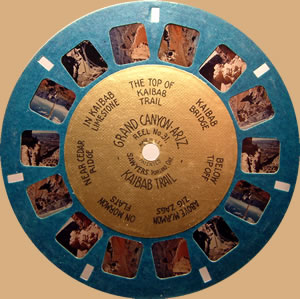 |
The very early first reels produce by Sawyer's were the Gold foil center
blue reels. They were produced from 1939 to 1940. Few were ever made
and only about 136 titles were ever issued as Gold foil reel. The first
titles issued had the words 'PAT APPLIED FOR' printed directly beneath
and around the center hole. On later titles, issued after February 1940,
'PATENTED' was printed in the same place. The Gold foil center reels are the only reel style of which the printing wasn't done directly on the reel. All the information was printed on a Gold foil label which was then attached to the blue reel. All Gold foil reels have the variety 1 hand-lettered printing type. |
| The second generation reel style is the Blue Ring reel. These reels were produced in 1940 and 1941. Probably because of the time consuming production of the Gold foil reel, production was shifted to the Blue Ring reel style. All information was printed directly on the Blue Ring reel and had the type 1 hand-lettered printing. The early blue ring reels were made of an orange and hard, waxed almost like plastic, cardboard type. |
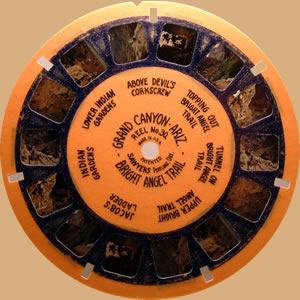 |
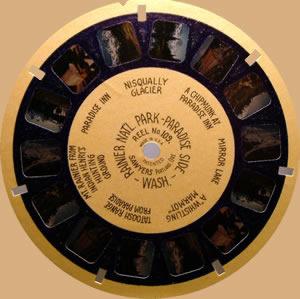 |
Later blue ring reels had a buff color and were fabricated on more normal cardboard. Blue ring reels normally have a blue back. The blue color around the scenes was maintained because this color would prevent light reflections from outside the viewer. At the end of the blue ring production some reels got a buff back instead of blue. Most Blue Ring reels have the variety 1 hand-lettered printing type, but also varieties 2, 3, 4 and 9 are known to exist. |
|
Buff or third generation reels where produced from 1941 through 1944.
Third generation reels also go by names as 'tan' or 'yellow' all referring
to the typical color of the reels. Another name these reels are sometimes
given is that of 'transition reels'. This because of the fact that there
are a lot of buff reels with different colors on the front and the back
of the reel. The early buff reels had a blue back. The backs used on the
blue-ring reels. Then came the period that the reels had a buff front
and back. Later on towards the end of the buff reel production the back
changed to white, off-white or gray. The colors of the reels of the next
generation. On top of this, buff reels are known to exist with yet another variation. The 'Speckled' reel. These blue speckles come in different intensities. From very subtle to almost totally blue. At some point in the production period the variety 1 'Hand-lettered' printing was changed. Buff reels with lettering varieties up to variety 13 are known. |
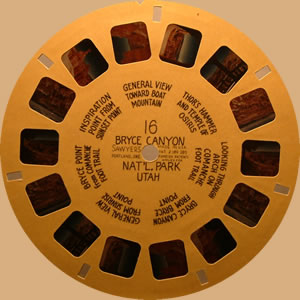 |
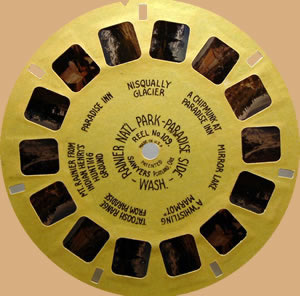 |
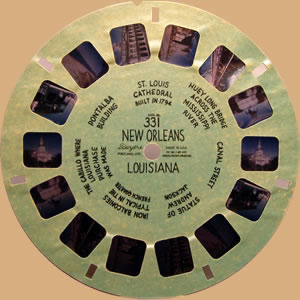 |
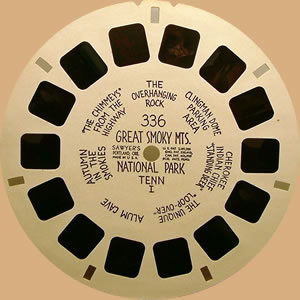 |
The fourth generation reel is called the 'hand-lettered
white'. All previous generations were hand-lettered too, but as an
addition to this fourth generation it makes the difference with the
fifth generation reels. Although this generation is called white,
certainly in the beginning of the production in 1944, the paper stocks
used to produce this reels was not white at all. Styles with off-white,
gray, light-brown and brown-red paper are known to exist. The normal
white reels are the most common and were produced until 1946. Like the buff reel, some white reels have the same blue speckled variation. The hand-lettered white reels are known to exist with all the hand-lettered varieties from variety 1 up to 18. |
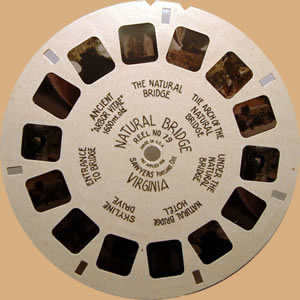
|
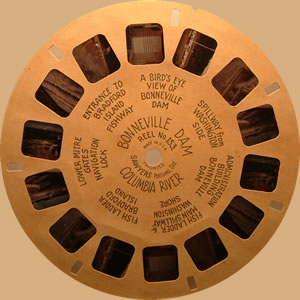 |
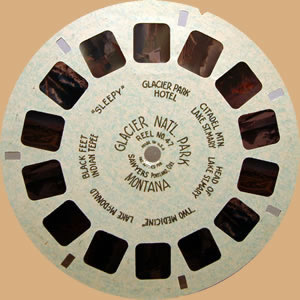 |
The story of the notches. Allmost all reels have notches. Some very early Gold-label blue reels don't, but most of the blue-ring and buff reels have one. The hand-lettered white reels have one or two and all typeset reels have two notches. The notches were needed to position the reel blanks into the mounting machines. The first mounting machines used one catch to hold the reels, the later machines used two. Somewhere along the time the hand-lettered white reels where in production they changed the mounting machines. So the early hand-lettered white reels have one notche, the later ones have two. The Gray hand-lettered white reel above has 2 notches, although the lettering has the circular variety even with 'Pat applied for' beneath the central hole. This shows that not only the printing type makes a reel an early one. |
| The fifth and final generation of reels is the typeset white reel. Its production started in 1946. This generation reel is still being used in production today. The text is printed in typeset lettering rather than the four previous hand-lettered generations. Furthermore all labeling is linear rather than the concentric style of lettering used before. During the production period of the typeset reel, scene numbers where introduced. The early typeset reel varieties still had no scene numbers but somewhere around the late 40's they appeared. All fifth generation reels are only printed on white paper stock. |
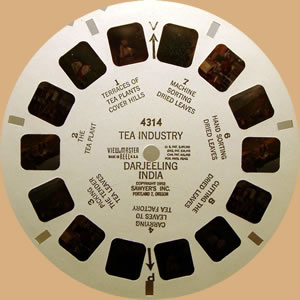 |
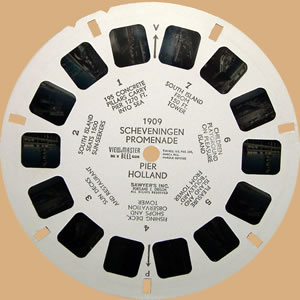 |
Even when prodution expanded to Europe (Belgium 1953) the reels
didn't change. Only the lines left from the center hole changed. The early varieties typeset reels, up to variety 47, all had in some form the words 'Sawyer's Inc., Portland Oregon' printed, most of the times with the addition 'Made in U.S.A.'. These lines where replaced with the words 'VIEW-MASTER, Made in REEL Belgium'. |
Even the very few reels made in France (by View-Master France in Lille around 1960) look almost the same.
Of course it says to the left of the center hole 'VIEW-MASTER, Made in REEL France'.
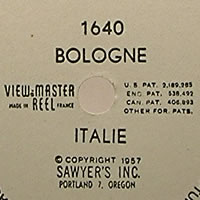 |
 |
 |
The typeset reels that differ somewhat from the U.S., the Belgian or the French typeset reels are those made in Australia, India and Spain.
There are five Australian typeset varieties. All the Australian made reels have 2 lines at the left and the right of the center hole.
To the left they reed 'VIEW-MASTER, REEL Made in Australia'. At the right it says 'SAWYER'S (INC), AUSTRALIA pty. limited'. Almost all the Austrailian single reels lack the copyright year. The Australian plant also issued some reels that were originally issued as one of the reels from a three reel packet. For example reel #A6552 Scenic Niagara Falls, Ontario, Canada, was issued as a single reel. This reel was originally issued as the second reel from the #A655 Scenic Niagara Falls three reel packet by the American plant. |
| The reels made in India only come in two variations which both have a copyright year. The printing on both varieties differs a lot on the left and right of the center hole. At the bottom of the center hole both variaties have the same information. The copyright year and SAWYER'S INC. Portland 7, Oregon. Funny to notice that the word copyright is spelled copy right on the reels made in India. |
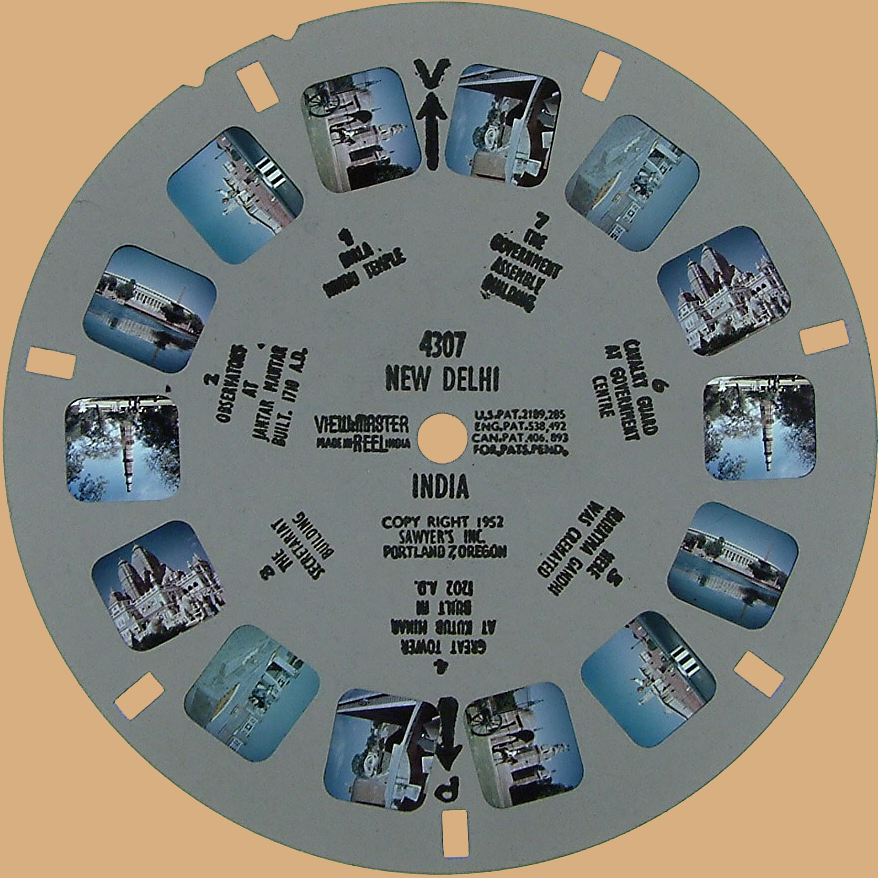 |
 |
Last but no least the reels made in Spain. At least we think they where made in Spain. There is no mention of 'Made in..' anywhere on tbe reels. These reels all have the same copyright year of 1950.
At the left of the center hole VIEW-MASTER DISCO is printed. The only known reels with another word for REEL. The Spanish reels are printed in a different font. These reels are by far hte most rare reels from the View-Master family. |